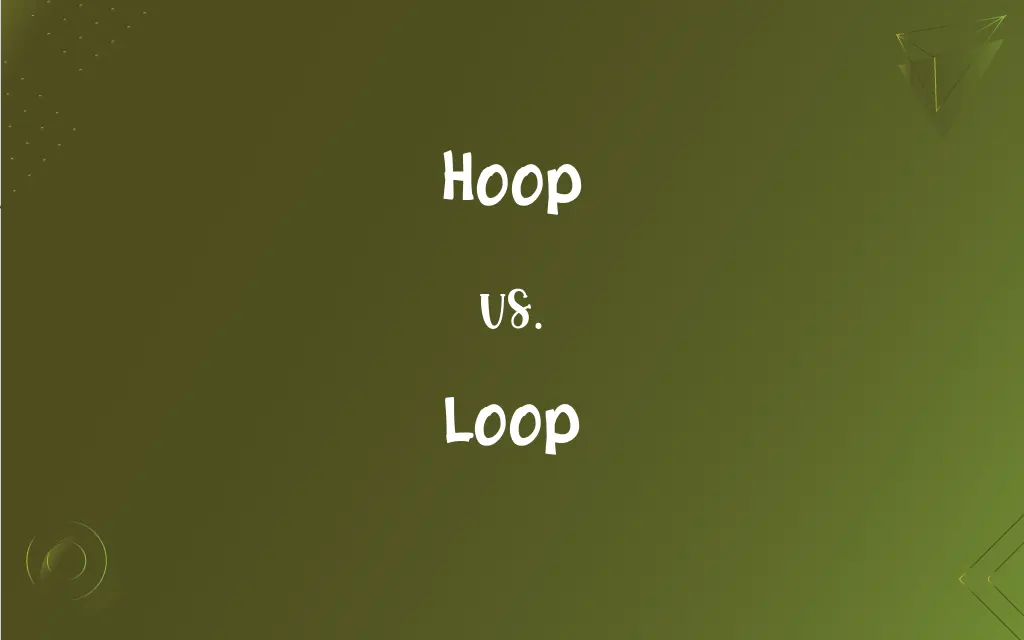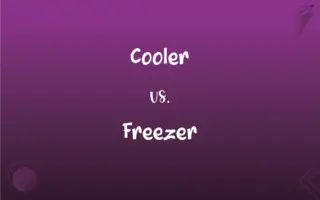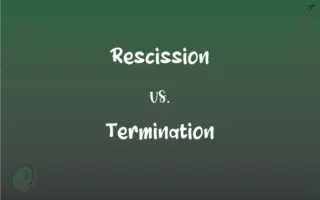Hoop vs. Loop: What's the Difference?
By Janet White & Harlon Moss || Updated on March 4, 2024
A hoop is a circular band or ring typically made of rigid materials for use in games, crafts, or as a structural element, whereas a loop is a curved or circular shape formed by anything flexible, often used to fasten, secure, or handle objects.

Key Differences
A hoop is often associated with objects like basketball hoops, embroidery hoops, or hoop earrings, characterized by their rigid form. They maintain a circular shape due to the stiffness of the materials from which they are made, such as metal, wood, or plastic. Hoops serve various purposes, from sports equipment to fashion accessories, emphasizing their shape and structural integrity. On the other hand, a loop is created when a flexible material, such as string, wire, or fabric, is bent or twisted into a circular or oval shape. Loops are integral to functionality in many contexts, including securing shoelaces, creating knots for climbing, or forming handle grips.
The concept of a hoop implies a fixed, often unchangeable shape that serves a specific function or purpose. For instance, the hoop of a barrel provides structural support, and the hoop in jewelry adds aesthetic value. Conversely, loops are dynamic and adaptable; they can be easily formed, undone, and reshaped according to the task at hand. This flexibility makes loops essential for temporary bindings, adjustments, and connections in both everyday and specialized tasks.
In terms of usage, hoops are frequently found in recreational and decorative contexts. They are essential components of sports equipment, such as basketball hoops, and crafts, like hoop art, where their circular shape is a key aspect of their functionality. Loops, however, are ubiquitous in both practical and decorative applications. They appear in functional designs, such as belt loops and loops in knitting, where their ability to fasten or connect is paramount.
The manufacture and design considerations for hoops and loops also differ. Creating a hoop involves selecting a material that can maintain a circular shape under stress or tension, requiring precise manufacturing techniques to ensure uniformity and durability. Designing loops focuses on the flexibility and strength of the material, ensuring that it can be easily manipulated while also capable of securing or supporting as needed.
Despite their differences, both hoops and loops play crucial roles in various objects and activities. Their unique characteristics make them suitable for a wide range of applications, from functional designs to recreational activities, highlighting the importance of shape, material, and purpose in determining their use.
ADVERTISEMENT
Comparison Chart
Definition
A circular band or ring made of rigid material.
A curved or circular shape formed by flexible material.
Material
Made of metal, wood, or plastic.
Made of string, wire, fabric, or other flexible materials.
Shape Stability
Maintains a fixed circular shape.
Can be easily formed, undone, and reshaped.
Primary Use
Used in games, crafts, and as structural elements.
Used to fasten, secure, or handle objects.
Flexibility
Rigid and maintains form.
Flexible and adaptable to different uses.
ADVERTISEMENT
Hoop and Loop Definitions
Hoop
Used in crafts for maintaining fabric tension.
The embroidery hoop kept the cloth tight while she stitched.
Loop
A way to create handle grips or attachments.
She added a leather loop to the bag for easy carrying.
Hoop
Circular jewelry, often worn as earrings.
Her silver hoop earrings complemented her outfit perfectly.
Loop
Used in fastening or securing objects.
The loop on her backpack broke, making it hard to carry.
Hoop
A circular band of metal or wood put around a cask or barrel to bind the staves together.
Loop
Integral to knitting and crochet patterns.
Each stitch formed a tiny loop, creating a delicate pattern.
Hoop
A large wooden, plastic, or metal ring, especially one used as a plaything or for trained animals to jump through.
Loop
A flexible circle formed by bending material.
He tied a loop at the end of the rope for a secure grip.
Hoop
One of the lightweight circular supports for a hoop skirt.
Loop
Part of systems for closure, like buttons or hooks.
The dress fastened at the back with a small button and loop.
Hoop
A circular, ringlike earring.
Loop
A length of line, thread, ribbon, or other thin material that is curved or doubled over making an opening.
Hoop
One of a pair of circular frames, usually of wood or plastic, used to hold material taut for embroidery or similar needlework.
Loop
The opening formed by such a doubled line.
Hoop
The basket.
Loop
Something having a shape, order, or path of motion that is circular or curved over on itself.
Hoop
A field goal
Hit a big hoop.
Loop
(Electricity) A closed circuit.
Hoop
Also hoops The game of basketball.
Loop
(Computers) A sequence of instructions that repeats either a specified number of times or until a particular condition is met.
Hoop
(Sports) A croquet wicket.
Hoop
To hold together or support with a hoop.
Hoop
To encircle.
Hoop
A circular band of metal used to bind a barrel.
Hoop
A ring; a circular band; anything resembling a hoop.
The cheese hoop, or cylinder in which the curd is pressed in making cheese
Hoop
A circular band of metal, wood, or similar material used for forming part of a framework such as an awning or tent.
Hoop
A circle, or combination of circles, of thin whalebone, metal, or other elastic material, used for expanding the skirts of ladies' dresses; hence, by extension a hoop petticoat or hoop skirt.
Hoop
A quart pot; so called because originally bound with hoops, like a barrel. Also, a portion of the contents measured by the distance between the hoops.
Hoop
An old measure of capacity, variously estimated at from one to four pecks.
Hoop
(basketball) The rim part of a basketball net.
Hoop
The game of basketball.
Hoop
A hoop earring.
Hoop
A horizontal stripe on the jersey.
Hoop
A jockey.
Hoop
An obstacle that must be overcome in order to proceed.
Hoop
(transitive) To bind or fasten using a hoop.
To hoop a barrel or puncheon
Hoop
(transitive) To clasp; to encircle; to surround.
Hoop
(dated) To utter a loud cry, or a sound imitative of the word, by way of call or pursuit; to shout.
Hoop
(dated) To whoop, as in whooping cough.
Hoop
A pliant strip of wood or metal bent in a circular form, and united at the ends, for holding together the staves of casks, tubs, etc.
Hoop
A ring; a circular band; anything resembling a hoop, as the cylinder (cheese hoop) in which the curd is pressed in making cheese.
Hoop
A circle, or combination of circles, of thin whalebone, metal, or other elastic material, used for expanding the skirts of ladies' dresses; crinoline; - used chiefly in the plural.
Though stiff with hoops, and armed with ribs of whale.
Hoop
A quart pot; - so called because originally bound with hoops, like a barrel. Also, a portion of the contents measured by the distance between the hoops.
Hoop
An old measure of capacity, variously estimated at from one to four pecks.
Hoop
A shout; a whoop, as in whooping cough.
Hoop
To bind or fasten with hoops; as, to hoop a barrel or puncheon.
Hoop
To clasp; to encircle; to surround.
Hoop
To utter a loud cry, or a sound imitative of the word, by way of call or pursuit; to shout.
Hoop
To whoop, as in whooping cough. See Whoop.
Hoop
To drive or follow with a shout.
Hoop
To call by a shout or peculiar cry.
Hoop
A light curved skeleton to spread out a skirt
Hoop
A rigid circular band of metal or wood or other material used for holding or fastening or hanging or pulling;
There was still a rusty iron hoop for tying a horse
Hoop
A small arch used as croquet equipment
Hoop
Horizontal hoop with a net through which players try to throw the basketball
Hoop
Bind or fasten with a hoop;
Hoop vats
Hoop
A rigid circular band for sports or decoration.
She scored by throwing the ball through the basketball hoop.
Hoop
A structural component in barrels or skirts.
The wine barrel was reinforced with several strong metal hoops.
Hoop
An element in games or toys.
The children enjoyed jumping through the colorful hoops during playtime.
FAQs
Are all hoops circular?
While hoops are typically circular, they can also be oval or slightly irregular, depending on their specific use and design.
Can loops be permanent?
Loops can be designed to be either temporary or permanent, depending on the material and method used to create them.
What is the significance of hoops in sports?
In sports, hoops serve as goals or targets in games like basketball and hoopla, fundamental to the game's objectives and rules.
What is a hoop used for?
A hoop is used in various applications, including sports equipment, crafts, decorative elements, and structural support.
What materials are commonly used to make hoops?
Hoops are commonly made from metal, wood, or plastic, chosen for their ability to maintain a rigid circular shape.
How is a loop different from a knot?
A loop is a simple circular form created by bending or twisting material, while a knot involves intertwining the material to secure it in place.
Do loops always require flexible material?
Yes, the creation of a loop relies on the material's flexibility to bend into a circular or curved shape.
How are loops utilized in fashion?
Loops are used in fashion for functional purposes, such as belt loops or button loops, and decorative elements, like loops in lace or embroidery.
Why are hoops important in barrel making?
Hoops provide structural integrity to barrels, holding the staves tightly together to contain liquids without leaking.
What role do hoops play in children's playgrounds?
In playgrounds, hoops are used in climbing structures, as targets in throwing games, and for physical coordination activities, contributing to children's physical development and enjoyment.
How do the uses of hoops and loops differ in crafts?
In crafts, hoops are used to maintain tension or form, such as in embroidery, while loops are used in techniques like knitting or crochet for creating patterns and textures.
Are there environmental considerations in producing hoops and loops?
Yes, environmental considerations include the materials' sustainability, the production process's energy consumption, and the end-of-life recyclability of hoops and loops.
Can the size of a loop be adjusted?
Yes, the size of a loop can often be adjusted by manipulating the material, making it versatile for various applications.
How are hoops used in fashion beyond jewelry?
Beyond jewelry, hoops are used in fashion to maintain the shape of garments, such as hoop skirts, or as decorative elements on purses and accessories.
What is the significance of loop size in climbing equipment?
In climbing equipment, the size of loops affects their strength, usability for attaching gear, and safety, requiring precise design and testing.
Is there a specific technique to create a loop?
Creating a loop can involve various techniques, including bending, twisting, or folding the material, depending on the flexibility and intended use.
How do loops contribute to the functionality of bags and luggage?
Loops on bags and luggage serve as attachment points for straps, keys, or other accessories, enhancing functionality and accessibility.
Can loops be used in electronic equipment?
Yes, loops are used in electronic equipment for cable management, securing components, and as part of connectors or fastening systems.
How do material properties affect the choice between a hoop and a loop for a specific application?
The choice depends on the required strength, flexibility, durability, and whether the shape needs to be maintained or adjusted, guiding the selection of materials for hoops or loops.
What innovations have been made in the design of hoops and loops?
Innovations include the development of adjustable and breakaway designs for safety, materials that enhance durability and flexibility, and designs that improve functionality and aesthetic appeal in various applications.
About Author
Written by
Janet WhiteJanet White has been an esteemed writer and blogger for Difference Wiki. Holding a Master's degree in Science and Medical Journalism from the prestigious Boston University, she has consistently demonstrated her expertise and passion for her field. When she's not immersed in her work, Janet relishes her time exercising, delving into a good book, and cherishing moments with friends and family.
Co-written by
Harlon MossHarlon is a seasoned quality moderator and accomplished content writer for Difference Wiki. An alumnus of the prestigious University of California, he earned his degree in Computer Science. Leveraging his academic background, Harlon brings a meticulous and informed perspective to his work, ensuring content accuracy and excellence.































































